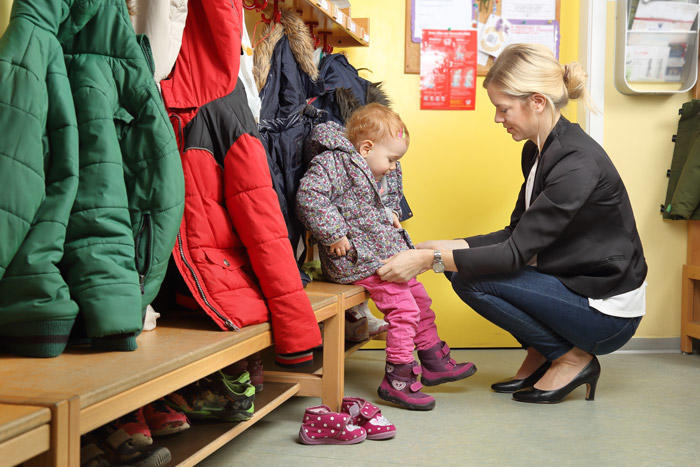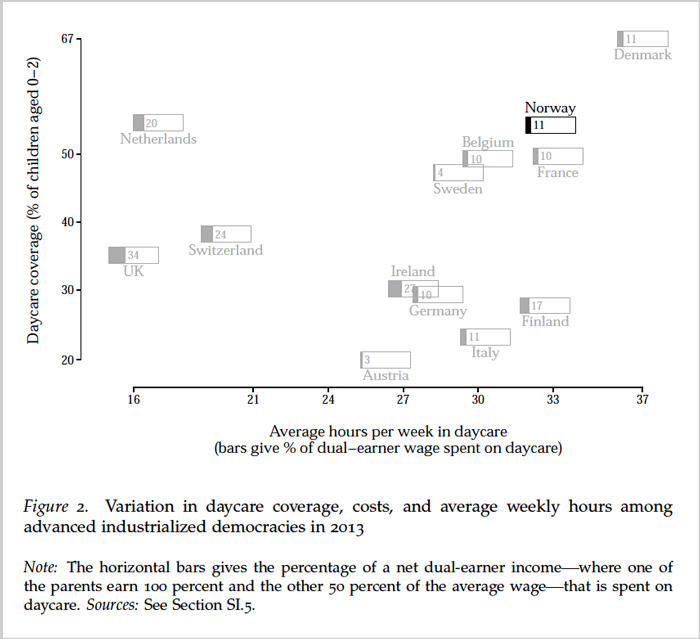New research shows that affordable and expanded daycare coverage in Norway has prompted more mothers to return to the workforce—and other countries may want to replicate their success.

By Michelle Nicholasen
To American parents struggling to find affordable childcare solutions, Norway might seem like a utopia: a place where parents who want affordable daycare, get it—or receive a cash payment if they don’t use it.
Norway has long provided subsidized daycare for children aged three and older. But the years between 2002 and 2008 were a time of sweeping reform. In 2002, the government increased federal financing for daycare, and it expanded full-time daycare services to include babies at the tender age of one. The aim was to get more mothers back into the workforce.
To find out if this radical reform achieved its goals, Weatherhead Center Postdoctoral Fellow Øyvind Skorge, and his colleague Henning Finseraas, both researchers at the Institute of Social Research in Oslo, evaluated and measured the effects that the reform had on working women. Their study found that expanded full-time daycare not only helped women attain higher level positions, but also increased their aspirations about work.
While Scandinavian countries have a long tradition of subsidized daycare, Norway had been more akin to European countries which have only limited coverage for toddlers. That was before expanded services under the reform. By 2008, three out of four one- and two-year-olds were enrolled in full-time daycare—up from 41 percent six years earlier.
“Prior to 2002, there were reforms that in practice expanded daycare, but not primarily for the youngest children, making it harder for women to go back to work when their children were very young,” Skorge explains.
When more daycare was made available, parents used it. Enrollment for one-year-olds increased from 29 to 66 percent, and for two-year-olds from 51 to 86 percent between 2002 and 2008. Honoring the reform mandate, the central government also increased its contribution to the point where it covered about 80 percent of the costs of daycare for families—this was on top of an existing and generous forty-nine-week parental leave policy. Today, parents’ payment for a full-time daycare spot is capped at less than 400 USD (among OECD countries, Norway ranks second in public expenditures for salary supports for new parents).

That daycare expansion would cause toddler enrollment to skyrocket is not surprising. The real test, according to Skorge and Finseraas, was to see the effect it had on women in the workplace. Previous studies had shown that it increased mothers’ labor force participation. Their study hypothesized that if a mother had reliable daycare in the early years of her child’s life, she would be available for more demanding jobs with longer hours, and ultimately be more likely to attain higher-level positions.
Norway is well known for its meticulous databases, so the researchers had access to public demographics on all births in the country that could be linked to a mother’s work status, education, and occupation level. They looked at 268,000 mothers who had at least one two-year-old child in the daycare expansion period (2002–2008), and followed them until their children turned eight. The team measured work hours and leadership representation over that time.
One important factor was the way the government transferred subsidies to Norway’s 400+ municipalities so they could increase local daycare sites. It delivered the funding in a staggered fashion over a six-year period; as a result, municipalities expanded their services at different times. This allowed the researchers to conduct a quasi-experiment, comparing employment outcomes of the early expanders to those of the late expanders.
The results showed that 28.4 percent of workforce leadership positions were held by women in 2003, and by 2008, that number had increased to 33 percent. Controlling for confounding effects, the researchers found that the reforms were achieving their intended goal of getting more mothers into higher-level positions.
“Now we have empirical evidence that affordable daycare can pave the way for women’s entrance into leadership positions, which are still heavily dominated by men,” Skorge says.
What’s more, the reforms appear to have increased women’s aspirations as well. Using data from the biannual Norwegian Monitor survey, which includes questions about attitudes towards women’s careers, the researchers were able to show that, due to the reforms, women increasingly saw their careers as important as men’s. Respondents were asked to rate their agreement with the statement: “Women have the same need for a professional career as men have.”
“We found that a 20-percent increase in daycare coverage in a municipality corresponds to a 12-percent increase in the probability of a mother fully agreeing with the above statement,” notes Skorge.
As improbable as it sounds to Americans—who spend an average of 34 percent of a dual-income on daycare, compared to Norwegian parents who spend 11 percent—Norway’s path to large-scale coverage is worth examining, because it was a synergy of political forces that brought the daycare issue to the forefront of the national agenda in 2002.

Getting an issue like more daycare to the top of the political agenda is a tall order, even in countries with the strongest social programs. The movement in Norway was driven by an unlikely alliance of constituent groups, but reflected an overall consensus that national competitiveness and vitality depended on leveraging the talents of motivated young women, who were increasingly becoming the most educated demographic group.
“Both labor unions and the employers’ associations were in agreement that you simply cannot be competitive if a large, highly educated, productive part of the labor force remains outside the labor force,” says Skorge.
What makes Norway unique among Western industrialized countries is the structure of its labor force. After the collapse of Fordism, union membership never declined as much in Scandinavia as it did in the US and UK, and remains around 50–60 percent. As a result, unions have political power. What’s more important, women have, since the turn of the millennium, made up more than 50 percent of union membership in Norway.
Employers’ organizations were also in alignment with daycare expansion, so the two often-opposed interest groups—union and corporate—joined forces on the same issue. This led to a coalition of strange bedfellows—the Socialist Left, the Labour Party, the agrarian Center Party, and the populist right-wing Progress Party, all on different wings of the political spectrum, came together on this issue. This parliamentary majority forced the minority government—consisting of the Christian Democrats, the Conservatives, and the Liberals—to embark on daycare expansion, with the aim of full daycare coverage with low parental fees. It was the Christian Democrats, however, who had the prime minister between 1997–2000 and 2001–2005 were not in favor of expanding daycare for the youngest children, because they advocated that a family member should raise children during the early years. They would rather parents get a cash payment to encourage a mom or dad to stay at home.
“All these opposition parties were looking for ways to distinguish themselves very clearly from the government, by offering daycare for the early years, counter to the Christian Democrat views at the time. And they also wanted to speak to a very important group of voters, working mothers and working women in general,” explains Skorge.

It was a classic case of coalition politics. Disparate parties came together to, in effect, force the government to do something they didn’t want to do. Then, in the 2005 general election, the Socialist Left—whose key base was educated, dual-earner families—joined forces with the Labor Party and the Centre Party to form a bloc, and won, allowing for an even more extensive rollout of daycare.
“Another factor was that we had the first ever female finance minister, Kristen Halvorsen, who really pushed for this reform,” says Skorge. “Halvorsen had made full daycare coverage a key promise to voters during the 2005 election campaign. Overall, there was very much a political willingness to spend political and financial capital to do this.”
Skorge believes that in advanced democracies such as Germany, Japan, and the UK, daycare has risen on the political agenda alongside an interest in increasing the labor supply of highly skilled, educated women. The Norwegian model, therefore, can be instructive to countries outside Scandinavia.
But could it ever happen in the US?
“I think politically it’s much more difficult given a two-party system and the absence of coordinated employers’ and trade unions. I think if daycare support were introduced, it could happen on a smaller scale. It might first happen at a county or state level,” says Skorge. “Especially where there’s a precedent for public investment in primary education, there might be room for daycare at some point.”
—Michelle Nicholasen, Communications Specialist, Weatherhead Center for International Affairs
Øyvind Skorge is a postdoctoral fellow in the Weatherhead Scholars Program at the Weatherhead Center for International Affairs. He is also a senior research fellow at the Institute for Social Research, Oslo. This article’s research on the effects of childcare coverage on women in the workforce is based on his working paper with his colleague Henning Finseraas called, “Care for career: mothers, toddlers, and the impact of daycare services on female leadership.”
Captions
- Figure 3. The percentage of children in formal daycare, 1963–2014. Credit: Øyvind Skorge and Henning Finseraas
- Figure 2. Variation in daycare coverage, costs, and average weekly hours among advanced industrialized democracies in 2013. Credit: Øyvind Skorge and Henning Finseraas
